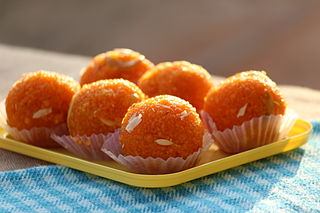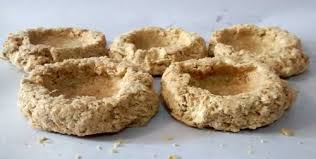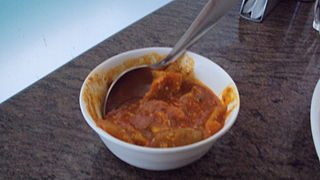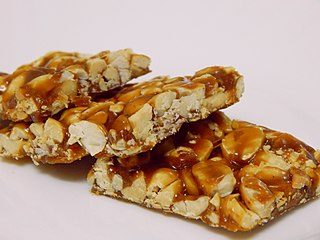
Jaggery is a traditional non-centrifugal cane sugar consumed in the Indian subcontinent, Southeast Asia, Central America, Pakistan, Brazil and Africa. It is a concentrated product of cane juice and often date or palm sap without separation of the molasses and crystals, and can vary from golden brown to dark brown in colour. It contains up to 50% sucrose, up to 20% invert sugars, and up to 20% moisture, with the remainder made up of other insoluble matter, such as wood ash, proteins, and bagasse fibres. Jaggery is very similar to muscovado, an important sweetener in Portuguese, British and French cuisine. The Kenyan Sukari ngutu/nguru has no fibre; it is dark and is made from sugarcane and also sometimes extracted from palm tree.

A Sehra or Sehro or Mundavalya ,(Marathi: मुण्डावळ्या) or Basikam is a forehead garland/nuptial crown worn by the bridegroom during weddings in Indian subcontinent. This decorative groom’s veil can be made either out of flowers or beads and is tied to the groom’s turban or Pagdi.

Laddu or laddoo is a spherical sweet from the Indian subcontinent made of various ingredients and sugar syrup or jaggery. It has been described as "perhaps the most universal and ancient of Indian sweets."

Tilkut also known as tilkutam, gajak, tilpatti, is a sweet made in the Indian states of Bihar, Jharkhand.

Puran poli is an Indian sweet flatbread that popular in South India and the state of Maharashtra. It is also known as Puran puri, Holige, Obbattu, Bobbattlu, Poley, Bakshamulu, and Boli.

Mukhwas is a colorful Indian Ayurvedic after-meal snack or digestive aid widely used as a breath freshener, especially after meals. As per Agamas, Mukhwaas forms one of the components of sixteen upcharas (offerings) to a deity in a Puja, the Hindu mode of worship or prayer. can be made of various seeds and nuts, often fennel, anise, coconut, coriander, and sesame. They are sweet in flavor and highly aromatic due to added sugar and the addition of various essential oils, including peppermint oil. The seeds can be savory or sweet—coated in sugar and brightly colored.

South Asian pickle is a pickled food made from a variety of vegetables and fruits preserved in brine, vinegar, edible oils, and various South Asian spices. The pickles are popular across South Asia, with many regional variants, natively known as lonache, avalehikā, uppinakaayi, pachadi or noncha, achaar, athāṇu or athāṇo or athāna, khaṭāī or khaṭāin, sandhan or sendhan or sāṇdhāṇo, kasundi, or urugaai.

Chikki is a traditional Indian and Pakistani sweet (brittle) generally made from nuts and jaggery/sugar. There are several different varieties of chikki in addition to the most common groundnut (peanut) chikki. Each variety of chikki is named after the ingredients used, which include puffed or roasted Bengal gram, sesame, puffed rice, beaten rice, or khobra, and other nuts such as almonds, cashews and pistachios.

Kadhi, or karhi, is a popular dish mainly consumed in South Asia. It consists of a thick gravy or soup based on gram flour, and it may contain vegetable fritters called pakora, which include dahi (yogurt) for a sour taste. It is often eaten with cooked rice or roti. Varieties of kadhi include those from Rajasthan, Maharashtra, Gujarat, Punjab, and Sindh, all of which are located in present-day India and Pakistan.

Luchi or Lusi or Luchui is a deep-fried flatbread, made of Maida flour. Luchi is especially popular in the Indian states of Uttar Pradesh, Madhya Pradesh, Bihar, Assam, Odisha, West Bengal and Tripura and in the neighbouring country Bangladesh.

The Satyanarayana Puja is a puja dedicated to the Hindu god Vishnu, who is also known as Satyanarayana.

Pithas are a variety of food similar to pancakes, dumplings or fritters, originating from the Indian subcontinent, common in Bangladesh and India. Pitha can be sweet or savoury, and usually made from a dough or batter, which is then steamed, fried or griddled. Very few varieties are oven-baked or boiled, and most are unleavened and cooked on a stovetop. Some versions may have a filling, garnish, or sauce. Few may be set or shaped after cooking. They are typically eaten as a snack with chai, or as treats during special occasions.
Bhojpuri cuisine is a style of food preparation common among the Bhojpuri people of Bihar and eastern Uttar Pradesh in India, and also the Terai region of Nepal. Bhojpuri foods are mostly mild and tend to be less hot in terms of spices used. The cuisine consists of both vegetable and meat dishes.

Chaas is a curd-based drink popular across the Indian subcontinent. In Magahi it is called Mattha. In Rajasthani it is called ghol, in Odia it is called Ghol/Chaash,moru in Tamil and Malayalam, taak in Marathi, majjiga in Telugu, majjige in Kannada, ale in Tulu and ghol in Bengali. In Indian English, it is often referred to as buttermilk.
Jolpan, or snacks, are often served at breakfast in the cuisine of Assam, although they may also be served at Bihu festivals or weddings. The word jolpan includes all the preparations namely jolpan, pitha, laru and tea. Other common items served for breakfast may include roti, luchi, ghugni and sometimes paratha etc. Jolpan are also found in Bengal. The word literally derives from "water and betel leaf" but can mean any snack.
Sattu is a type of flour, mainly used in Nepal, Tibet, Pakistan, and India. It consists of a mixture of roasted ground pulses and cereals. The dry powder is prepared in various ways as a principal or secondary ingredient of dishes. Sattu is used in vegetarian cuisine as it can be a source of protein.
Fenia or Pheniyaan is a form of vermicelli from the Indian subcontinent, notably North India. Although similar to the vermicelli used in seviyan and falooda,pheniyaan are much thinner. They have a ritualistic importance for the Karva Chauth festival where, along with Lapsi and dry fruits, they are part of the sargi ensemble consumed just before the fast associated with the festival begins.

Sesame seed candy is a confection of sesame seeds and sugar or honey pressed into a bar or ball. It is popular from the Middle East through South Asia to East Asia. The texture may vary from chewy to crisp. It may also be called sesame (seed)candy/bar/crunch; sesame seed cake may refer to the confection or to a leavened cake or cookie incorporating sesame.
Katt Bafla is a popular and traditional dish from the Bundi district of Hadoti region in Rajasthan, India. It is a famous dish across the north Indian states in India. Traditionally this dish is made on every occasion in Rajasthan. In this dish Bafla is a type of spherical wheat bread whereas the Katt is a type of Barfi made with a mixture of unsalted wheat bread coarse powder with ghee and jaggery powder. Traditionally this dish is served with Daal and Kadhi.














